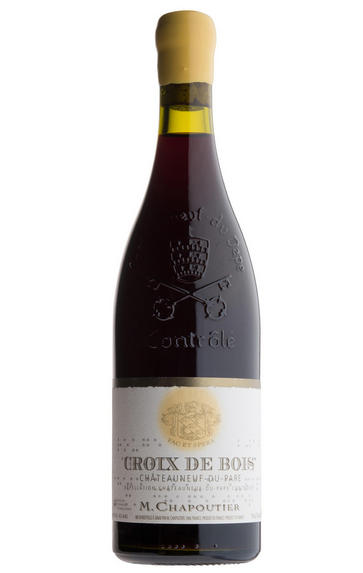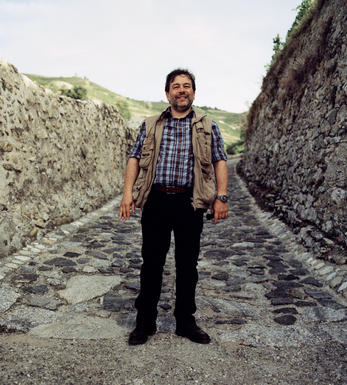
2013 Châteauneuf-du-Pape, Croix de Bois, M. Chapoutier, Rhône

Critics reviews
Jeb Dunnuck - 30/10/2015
About this WINE

Maison Chapoutier
Applying his usual break-neck rigour to the presidency of InterRhône has not in any way distracted Michel Chapoutier. His range is more impressive in scope than ever, providing the most complete dissection of the region’s styles and terroir. Founded in 1808, Michel took charge in 1988 and became the seventh generation of his family to run the domaine. Since then, quality has soared and he is now farming all his vineyards biodynamically. He also invests in new winemaking projects across the globe, as far-flung as Australia. His children, in particular his daughter, Mathilde, are now increasingly involved in the day-to-day management of the maison, bringing with her her entrepreneurial skills and vision.
Michel describes 2021 as a vintage the vignerons were unlikely to forget in a hurry, bringing an array of challenges that only hard work could overcome. It also brought a style of wines he thought long forgotten: ethereal in nature, with aromatic complexity, lower alcohols and bright acidities. They offer great elegance and finesse overall.
You might remember that we offered Chapoutier’s 2021 sélection parcellaire back in October last year – an impressive range of his single vineyards, including his prestigious Ermitages. We do have small volumes left of some lines so if you’re interested in seeing a complete list, please speak to your Account Manager.
Châteauneuf-du-Pape
The most celebrated village of the Southern Rhône, Châteauneuf-du-Pape is the birthplace of the now indispensable French Appellation d’Origine Contrôlée system – imperfect though it may be. Compared to the Northern Rhône, the vineyards here are relatively flat and often feature the iconic galet pebbles – the precise benefits of which are a source of much debate. Minimum alcohol levels required by the AOC are the highest in France, but at 12.5% it is well below the natural generosity of Grenache, which only achieves its full aromatic potential when it is fully ripe and laden with the resultant high sugars. Syrah and Mourvèdre contribute the other defining elements in the blend, adding pepper, savoury spice and structure to the decadent Grenache. There are a further 10 permitted red grape varieties which can be used to adjust the “seasoning”. Of the five white varieties permitted, it is Grenache Noir’s sibling – predictably perhaps – Grenache Blanc, which dominates, though Roussanne shows a great deal of promise when handled well, notably at Château de Beaucastel.

Southern Rhône Blend
The vast majority of wines from the Southern Rhône are blends. There are 5 main black varieties, although others are used and the most famous wine of the region, Châteauneuf du Pape, can be made from as many as 13 different varieties. Grenache is the most important grape in the southern Rhône - it contributes alcohol, warmth and gentle juicy fruit and is an ideal base wine in the blend. Plantings of Syrah in the southern Rhône have risen dramatically in the last decade and it is an increasingly important component in blends. It rarely attains the heights that it does in the North but adds colour, backbone, tannins and soft ripe fruit to the blend.
The much-maligned Carignan has been on the retreat recently but is still included in many blends - the best old vines can add colour, body and spicy fruits. Cinsault is also backtracking but, if yields are restricted, can produce moderately well-coloured wines adding pleasant-light fruit to red and rosé blends. Finally, Mourvèdre, a grape from Bandol on the Mediterranean coast, has recently become an increasingly significant component of Southern Rhône blends - it often struggles to ripen fully but can add acidity, ripe spicy berry fruits and hints of tobacco to blends.


Buying options
Add to wishlist
Description
From the Bédarrides commune in the south-east of the appellation, Croix de Bois is a monovarietal Grenache, and one which is seemingly careless of some of the problems which beset that varietal in 2013. Reserved at the moment than the wine has plenty of matière, spice and poised tannin, ensuring that its evolution will be fascinating to follow.
Simon Field MW - Rhône Buyer
In the late autumn of 2014 I was lucky enough to blind-taste a range of red Hermitage wines with John Livingstone- Learmonth and Andew Jefford. I have yet to see the final article, yet it emerged that my top two wines were both Chapoutier Parcellaires. This is a truly outstanding range, as indeed one would hope it to be, given the historical reputation of the hill of Hermitage and the fact that Chapoutier are in the enviable position of owning more of its vines than anyone else. A great responsibility, which they discharge with consummate skill.
In the same ballpark, the 2013 Châteauneuf du Pape Croix de Bois has a softer, more upfront and textured feel then the Barbe Rac, which always seems to me to be slightly more serious and focused. Giving up loads of jammy blackberry and assorted darker fruits, licorice, and wild herbs, this full-bodied, ripe and layered effort makes the most of the vintage. It will drink nicely on release and dish out plenty of pleasure through 2023.
Jeb Dunnuck - Wine Advocate Issue#215 Oct 2014
wine at a glance
Delivery and quality guarantee